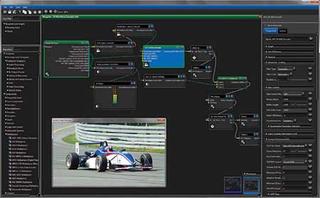Imagine Sees an All-IP Future for Broadcast
LAS VEGAS—Last year when Harris Broadcast changed its name to Imagine Communications, it reflected an expanded mindset and the beginnings of a new portfolio of products and expertise that had really started rolling forward months before. This accelerated when the company acquired transcoding leader Digital Rapids at the fall IBC Show, followed by more acquisitions and product launches that transformed the company.
“We have very consciously and very proactively over the last year moved Imagine forward from being a legacy broadcast company into a thought leader and technology leader within the television segment,” said Steve Reynolds, chief technology officer of Imagine Communications.
One very obvious example of the transformation was the integration of Digital Rapids. “We took the core technology that Digital Rapids had and did quite a bit of expansion on it, and really are now using that technology as a cornerstone for building new products,” Reynolds said.
The result is the Zenium workflow manager and the latest version will be at Imagine’s NAB Show booth in the North Hall (N2702) in the Las Vegas Convention Center. It is an agile software engine that enables media companies to design, deploy and manage extensible, customizable software-defined workflows. Its modular architecture provides technologies as service-enabling components—from media functions like encoding, packaging and processing to business-oriented functionality such as analytics, automated intelligence and reporting.
HYBRID BASEBAND/IP WORLD

At the Imagine Communications NAB Show booth, the company will show the new Zenium workflow manager, which was integrated with technology from its acquisition of Digital Rapids. Visitors to the Imagine booth will see many live demonstrations, not power points or “slideware,” according to Reynolds. One core area will cover the infrastructure transition from baseband to hybrid baseband/IP, and ultimately to IP. Here, new products will be running live, showing what the company’s been doing to facilitate hybrid IP/baseband infrastructures.
“There’s a very critical interim phase… a hybrid/baseband IP world,” Reynolds said. “We’ve done a lot of architectural work around that. And we’ve done a lot of product work around that… we’ll have signals running in that model, and we’ll have the latest version of the Magellan Orchestrator there.”
Get the TV Tech Newsletter
The professional video industry's #1 source for news, trends and product and tech information. Sign up below.
The Magellan Software Defined Networking Orchestrator (Magellan SDNO) can manage elements in both baseband and IP areas. “It has intelligence built in to it to manage routing in both domains and to manage routing between those domains,” Reynolds said. “It knows how to map an SDI input to an IP output… and vice versa.”
NEXT-GEN ADVERTISING
Imagine will also focus on nextgeneration advertising at its booth. “You’ll see things like dynamic ad insertion… you’ll also see some discussion around what’s called programmatic buying,” Reynolds said. “The buy-sell relationship in advertising is moving toward an electronic and automated model, which necessitates the development of programmatic interfaces on top of the ad sales system to allow that transaction to occur.”
The advertising side of the business is transforming from a spot-based model with linear ad insertion to impression-based multiplatform and multiscreen delivery to enable unicast and VOD ad management.
Advertisers now have many options in how to analyze an audience, according to Reynolds. “It’s no longer a mass market where you’re buying a specific spot on a specific channel, but rather you now have the ability to do segmentation of that audience and at some point even addressable delivery,” he said.
Another core area is migration toward the cloud and a virtualized software environment, with playout as an example. “We think that’s a major trend in that segment of the industry,” said Reynolds, and Versio will be running here.”
Multiscreen delivery will also be an important topic of discussion at Imagine’s booth, according to Reynolds. “For us this was really accelerated by the RGB acquisition—how do you distribute video across the Internet or across an IT network to all of these new endpoint devices that want to consume video in the form of packets?” he said.
Announced in January, the RGB Networks acquisition enhanced Imagine’s end-to-end video distribution capability with RGB’s stable of dynamic ad insertion, just-in-time packaging and cloud DVR technologies.
Last month the company announced that it will preview the Azure Media Services Premium Encoder at its NAB Show booth. The product, which resulted from a collaboration between Imagine and Microsoft, is a new cloud offering that allows broadcast-quality streaming to virtually any device worldwide, according to the vendors.
Azure Media Services Premium Encoder enables companies to design and launch scalable, cloud-based media processing applications, workflows and services on-demand. It integrates a studio-quality processing engine with automated decision-making logic and advanced metadata processing. It also supports input and output codecs and file formats like 4K Ultra HD in AVC and closed captioning.
Another new product introduced last month is CloudXtream, a comprehensive cloud video platform for multiscreen video distribution and monetization. The product—which will be shown at the Imagine booth—is designed to meet the growing and complex array of video distribution requirements, including live video, VOD, cloud DVR, dynamic ad insertion, packaging, encoding, transcoding, storage management and cloud orchestration.
4K EVOLUTION
On the topic of 4K, Reynolds said it will be interesting to see from the consumer side what drives adoption: more pixels, more color or a higher frame rate. He said that 4K and UHDTV is moving forward independently of HEVC H.265 encoding, but both can enhance the other to some extent.
“As large distributors [cable , satellite and cellular], look at how they are going to move video across their plant, it inevitably comes back to a discussion of compression,” Reynolds said. “HEVC is the next step forward, and we will see most 4K video carried on HEVC. Both are moving forward independently.”
Reynolds added that the company is continuing to invest in its baseband portfolio because in reality, the industry still runs on SDI, which Imagine believes will continue to be a very robust business.
As an example he mentioned the recent launch of the Platinum VX small- to midsized routers to replace the established Panacea line. The VX series brings some of the high-end technology found on the company’s larger routers at a lower price point and in smaller sizes.

